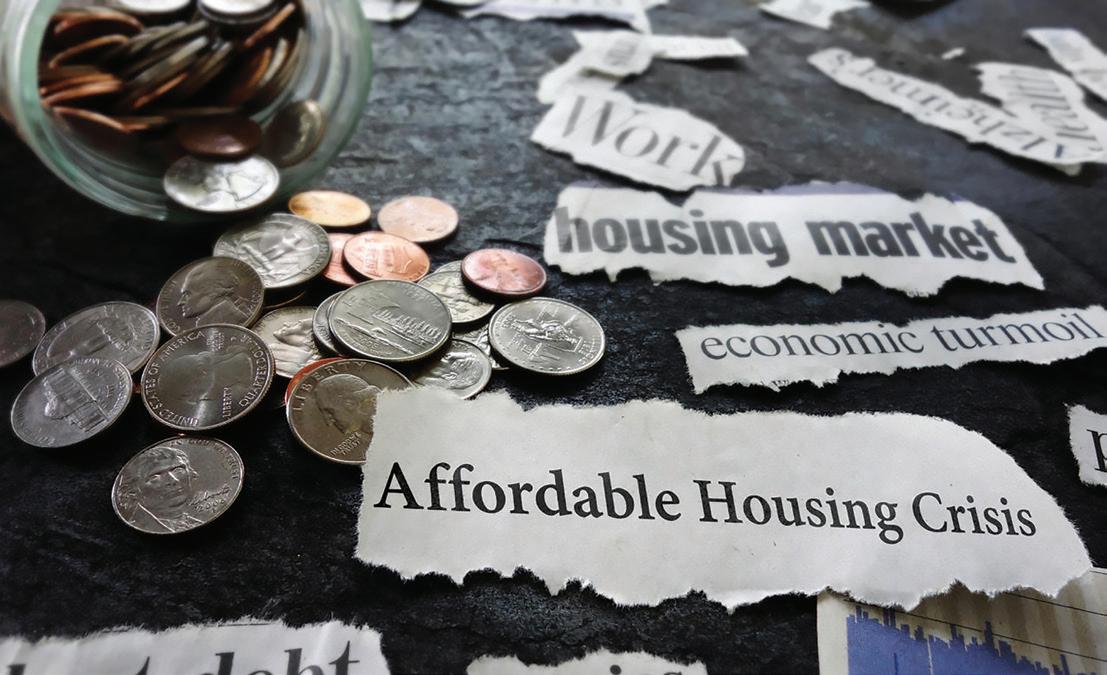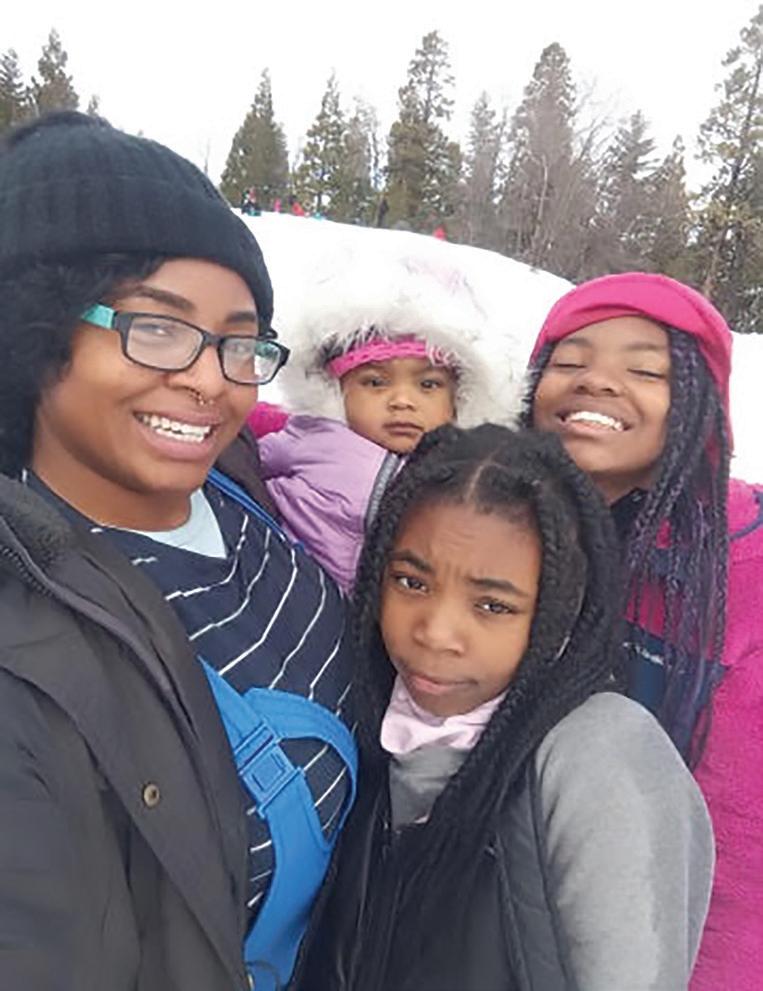
10 minute read
How the West Coast’s Only Heat Officer is Cooling LA
By Selen Ozturk
Black Borrowers May Be Biggest Beneficiaries of Biden Student Loan Forgiveness ...continued said President Joe Biden on announcing the action.
Advertisement
Foremost among these resources are cooling centers; in Los Angeles, currently 119 are open. “We’ve established cooling centers and hydration resources throughout the city in facilities like libraries, senior centers and community centers,” said Segura.
LA Chief Heat Officer Marta Segura is responding to the heat waves scorching Southern California as a public health crisis.
LOS ANGELES — As tripledigit summer temperatures sweep Southern California, Marta Segura is treating extreme heat as a public health crisis.
Segura, LA’s Climate Emergency Mobilization Director, also became its first Chief Heat Officer (CHO) in June 2022. As the region has seen record July heat with little relief, she has prioritized accessibility to cooling resources, particularly for underserved LA communities.
Extreme heat, the country’s top weather-related killer, is generally defined as at least two to three days of high heat and humidity with temperatures above 90 degrees Fahrenheit.
On an extreme heat day, there’s an average of 8,222 more emergency room visits across California for related issues. Of these, 1,510 are in LA County alone. An estimated 16 additional people there die on the first day of extreme heat, with 40 more deaths a day by the fifth.
These hospitalizations and deaths disproportionately affect communities of color living in low-income, historically redlined neighborhoods, said Segura, “where the houses don’t have AC or air filtration.
When you start approaching heat vulnerability that way, it’s not only a sustainability issue — it’s public works, building development, water and power, tree shade and park access, and certainly a matter of public health.”
Heat is the top public health risk in LA, which experiences heat waves five times more often than it did 10 years ago.
As extreme heat waves in Los Angeles become longer, more frequent and more intense, public outreach becomes ever-more crucial. Across her Heat Relief 4 LA social media campaign, Segura emphasizes that “It’s not your typical summer anymore. Extreme heat can run from June to November. As this means our bodies have less time to recover, we also distribute information on symptoms of heat exhaustion and heatstroke, and resources to cool off before hitting that point.”
“We also made an app, Cool Spots LA, where you can find where and when they’re open, alongside other cooling spots like shade structures, hydration stations, and bus shelters.” Currently, only a quarter of all LA Metro bus stops are shaded.
The need for heat interventions like these can vary drastically from neighborhood to neighborhood, partly because of the region’s coastal and inland microclimates. Accordingly, the city’s emergency alert system now uses National Weather Service data to identify heat wave severity in specific parts of LA.
However, these stark regional heat differences also owe to shade inequity. Research shows that with each 10% of canopy cover, trees keep ground-level temperatures about 2 degrees cooler. In a city where over half the surfaces are dark concrete or asphalt — which absorbs up to 90% of solar radiation — 20% of tree canopies are concentrated in four neighborhoods where less than 1% of the population live.
To address this inequity, 65,000 trees have been planted citywide in continuation of a 2019 plan by former Mayor Eric Garcetti to increase canopy coverage 50% by 2028 across LA’s least green neighborhoods. The aim is 90,000 trees by 2028.
Environmental inequity is a testament to why extreme heat is a public health issue, said Segura. “LA’s least green areas are historically disadvantaged neighborhoods where we not only see more heat-related illnesses but also more pollution and exacerbated chronic illnesses like asthma.” Hence, life expectancy in wealthy areas with ample green space like Beverly Hills is as high as 90, while that in disadvantaged south LA neighborhoods less than 15 miles away is as low as 77.
Thus, she continued, when heat policies “coordinate with departments across the city, the county, and” — under Gov. Gavin Newsom’s historic $800 million Extreme Heat Action Plan — “the state, the result can be life-saving.” Nevertheless, CHOs remain rare. Segura is joined by only two in the nation — in Phoenix, Arizona and Miami, Florida — and seven worldwide.
However, she continued, it’s becoming a matter of course for cities to develop not only general climate plans, but also heat action plans. These are largely a matter of “short-term planning for public engagement and emergency response, and longterm planning for public health and resilient infrastructure,” she added.
The heart of her work as LA’s CHO, Segura said, is aligning climate equity gaps with public health results: “to treat one is to improve the other. We can see the results all over the world — if we have no plan, it’s only going to get hotter and hotter.”
Black Borrowers May Be Biggest Beneficiaries of Biden Student Loan Forgiveness
804,000 federal borrowers to receive $39 billion in cancellations
By Charlene Crowell
Southern California Education Leaders to Address Inequities and Remove Barriers for BIPOC Students, Parents, and Staff
The first ‘Learn.Lead.Liberate’ conference will be held on July 27th
WHAT: The 21st Century California School Leadership Academy (21CSLA) and the Los Angeles Education Partnership (LAEP) will host a one-day conference for Southern California education leaders in to discuss ways to create educational environments that work to undo inequity and injustice. The conference will be free, and those interested in attending can register Imperial, Orange, Riverside, San Bernardino, and San Diego counties here.
These leaders will also learn how to remove barriers to foster communities that support and honor BIPOC students, parents, and staff, through evidencebased educational practices that treat the differences and student’s experiences outside of school as assets, so they can be valued, regardless of socio-economic or ethnic background.
Zaretta Hammond, author of Culturally Responsive Teaching and the Brain, will be the keynote speaker. She is a curriculum developer, consultant, and coach who has spent the past 15 years translating the latest research and teacher experiences on equity, literacy, and culturally responsive teaching into practical tools and strategies. Hammond started her career in the classroom, where she began to understand how important literacy was to equity, and how neuroscience and culture should inform our instructional practice.
“Our aim is to provide a forum where these leaders can gather to network and share information about what is working in their communities,” said Michele Broadnax, President, and CEO, Los Angeles Education Partnership. “We want to emphasize that these leaders don’t need to do this alone, as 21CSLA and LAEP are here to support them. We see and appreciate the dedication these educators have to this important work.”
WHEN: Thursday, July 27th, 8 a.m. to 4 p.m.
WHERE: The Mission Inn, 3649 Mission Inn Avenue, Riverside, CA, 92501
MEDIA CONTACT: Berry Brady, berry_brady@yahoo. com, 703-609-6643 LAEP is the Regional Academy providing 21CSLA programming in Imperial, Orange, Riverside, San Bernardino, and San Diego counties.
When the Biden Administration announced its latest initiative to reduce the nation’s unsustainable trillion-dollar student debt, both borrowers and advocates rejoiced. In the coming weeks an estimated 804,000 student loan borrowers will together receive $39 billion in federal loan debt cancellations.
These unprecedented debt cancellations are available due to systemic corrections that will now ensure all borrowers receive full credit for qualifying payments under the Department’s Income Driven Repayment (IDR) plans.
More importantly, these developments signal one of the very few times that Black student loan borrowers stand to become the initiative’s biggest beneficiaries. Recent data analyses underscore the extra student debt borne by Black America.

To paraphrase President Biden’s reaction to national health being passed when he served as President Barack Obama’s Vice President, ‘This is a big deal’.
According to the Education Data Initiative:
Black college graduates owe an average of $52,000 in student loan debt;
Over half of these borrowers say their net worth is less than their student debt;
“By fixing past administrative failures, we are ensuring everyone gets the forgiveness they deserve, just as we have done for public servants, students who were cheated by their colleges, and borrowers with permanent disabilities, including veterans,” added Secretary of Education Miguel Cardona.
Borrowers receiving notifications in the coming days include those with Direct Loans or Federal Family Education Loans held by the Department (including Parent PLUS loans of either type) who have reached the necessary forgiveness threshold as a result of receiving credit toward IDR forgiveness for any of the following periods:
Any month in which a borrower was in a repayment status, regardless of whether payments were partial or late, the type of loan, or the repayment plan;
Any period in which a borrower spent 12 or more consecutive months in forbearance;
Any month in forbearance for borrowers who spent 36 or more cumulative months in forbearance;
Any month spent in deferment (except for in-school deferment) prior to 2013; and
Any month spent in economic hardship or military deferments on or after January 1, 2013.
Discharges will begin 30 days after emails are sent. Then, borrowers will receive a second notice – from their loan servicer - after their debt is discharged. Those receiving forgiveness will have repayment on their loans paused until their discharge is processed, while those who opt out of the discharge will return to repayment once payments resume.
“My Administration has worked hard to secure the largest increases to Pell Grants in a decade, fixed broken loan programs such as Public Service Loan Forgiveness and created a new income-driven repayment plan that will cut undergraduate loan payments in half and bring monthly payments to zero for low-income borrowers,” said President Joe Biden on announcing the action.
“By fixing past administrative failures, we are ensuring everyone gets the forgiveness they deserve, just as we have done for public servants, students who were cheated by their colleges, and borrowers with permanent disabilities, including veterans,” added Secretary of Education Miguel Cardona.
The Center for Responsible Lending (CRL) applauded the Administration for forgiving hundreds of thousands of loans through the improved incomedriven repayment program. It commended the action as a critical step but highlighted the need for more work to be done.
“We look forward to working with the Administration to develop additional programs and regulations that will make the repayment of federal student loan debt fairer and more affordable,” said Jaylon Herbin, director of federal campaigns at CRL. “Hard-working Americans pay for a broken student loan system that was supposed to be designed for them. Instead, banking and education industry lobbyists turned it into a cash cow for themselves, skyrocketing tuition costs and telling low-andmiddle income families not to worry, ‘the debt will pay for itself.’ More than two decades later, these borrowers were still paying their loans.”
“Working people with student loan debt have been made collateral damage by a dysfunctional student loan system,” said Persis Yu, Deputy Executive Director and Managing Counsel with the Student Borrower Protection Center.
Tom Shapiro, a Brandeis University professor and author of several reports examining the nation’s nagging racial wealth gap, offered in earlier research a succinct summary of Black America’s financial disparities.
“As somebody who has looked at racial wealth inequality for a long time, I didn’t have to think long and hard about why that would be the case,” Shapiro says. “African American and Latinx student borrowers finish higher education at a lower rate and come out with higher debt. So, they pay more for college and get less out of it.”
Black student loan borrowers are the most likely to struggle financially to make a $250 monthly payment; and
Four years after graduation, Black loan borrowers owe an average of 188 percent more on their debt than whites.

Further, as of June 1, 2021 –long before this new initiative, only 157 borrowers received forgiveness from the Education Department, despite the fact that thousands more were also eligible, according to the federal Government Accountability Office (GOA). This office also found that about half of more than $1 trillion in outstanding federal student Direct Loans are being paid by borrowers using IDR plans.
Now, federal loan borrowers who have reached the equivalent of either 20 or 25 years of qualifying months will be benefit. Additionally, loan payments made prior to a loan consolidation will also be counted toward forgiveness.
“My Administration has worked hard to secure the largest increases to Pell Grants in a decade, fixed broken loan programs such as Public Service Loan Forgiveness and created a new income-driven repayment plan that will cut undergraduate loan payments in half and bring monthly payments to zero for low-income borrowers,”
Padilla Urges OSHA to Implement Federal Heat Protections for Workers...continued on page 4
Scott (VA-03), Chairman of the Committee on Education and Labor, Colin Z. Allred (TX-32), Nanette Diaz Barragán (CA44), Ami Bera, M.D. (CA-06), Earl Blumenauer (OR-03), Suzanne Bonamici (OR-01), Jamaal Bowman, Ed.D. (NY16), Brendan F. Boyle (PA-02), Shontel M. Brown (OH-11), Cori Bush (MO-01), Yadira Caraveo, M.D. (CO-08), Salud Carbajal (CA-24), Troy Carter (LA-02), Joaquin Castro (TX-20), Sheila Cherfilus-McCormick (FL20), Yvette D. Clarke (NY-09), Emanuel Cleaver, II (MO-05), Steve Cohen (TN-09), Jasmine Crockett (TX-30), Madeleine Dean (PA-04), Rosa L. DeLauro (CT-03), Chris Deluzio (PA17), Mark DeSaulnier (CA-11), Debbie Dingell (MI-06), Lloyd Doggett (TX-37), Adriano Espaillat (NY-13), Dwight Evans (PA-03), Valerie P. Foushee (NC04), Maxwell Frost (FL-10), Ruben Gallego (AZ-03), Jesús G. “Chuy” García (IL-04), Robert Garcia (CA-42), Dan Goldman (NY-10), Jimmy Gomez (CA34), Josh Gottheimer (NJ-05), Chrissy Houlahan (PA-06), Val Hoyle (OR-04), Sheila Jackson Lee (TX-18), Pramila Jayapal (WA-07), Henry C. “Hank” Johnson Jr. (GA-04), Ro Khanna (CA-17), Daniel T. Kildee (MI08), Raja Krishnamoorthi (IL08), Rick Larsen (WA-02),
Barbara Lee (CA-12), Summer Lee (PA-12), Mike Levin (CA49), Ted W. Lieu (CA-36), Zoe Lofgren (CA-18), Seth Magaziner (RI-02), Doris Matsui (CA-07), Betty McCollum (MN04), Morgan McGarvey (KY-03), Robert J. Menendez (NJ-08), Grace Meng (NY-06), Joseph D. Morelle (NY-25), Jerry Nadler (NY-12), Donald Norcross (NJ01), Eleanor Holmes Norton (DC), Alexandria Ocasio-Cortez (NY-14), Ilhan Omar (MN-05), Dean Phillips (MN-03), Chellie Pingree (ME-01), Mark Pocan (WI-02), Katie Porter (CA47), Delia C. Ramirez (IL-03), Jamie Raskin (MD-08), Raul Ruiz, M.D. (CA-25), C.A. Dutch Ruppersberger (MD-11), Patrick Ryan (NY-18), Linda T. Sánchez (CA-38), Mary Gay Scanlon (PA05), Jan Schakowsky (IL-09), Brad Sherman (CA-32), Adam Smith (WA-09), Darren Soto (FL-09), Haley M. Stevens (MI11), Mark Takano (CA-39), Shri Thanedar (MI-13), Dina Titus (NV-01), Norma J. Torres (CA35), Ritchie Torres (NY-15), Lori Trahan (MA-03), David J. Trone (MD-06), Juan Vargas (CA-52), Marc A. Veasey (TX-33), Nydia Velásquez (NY-07), Debbie Wasserman Schultz (FL-25), Bonnie Watson Coleman (NJ12), Nikema Williams (GA-05), and Frederica S. Wilson (FL-24).





